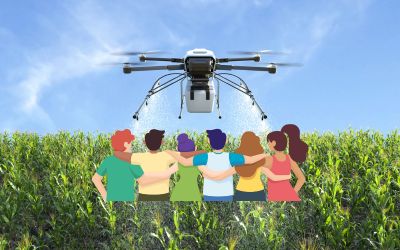Introduction
Encouraging sustainable agriculture is a comprehensive strategy that emphasises smallholder farming’s long-term profitability and sustainability. It strives to encourage the use of sustainable agricultural techniques that are socially, economically, and environmentally responsible. It considers the social, economic, and environmental elements of farming. This strategy recognises the relevance of varied types of crops and livestock, as well as the need for soil protection, water management, and biodiversity preservation. Smallholder farmers can enhance their standard of living, lessen poverty, and help protect the environment for coming generations by promoting sustainable agriculture.

There are initiatives in place to deal with these issues. This essay explores the challenges smallholders confront, the function of agricultural insurance, and the requirement for an all-encompassing strategy.
Challenges in Smallholder Agricultural Insurance
There are many obstacles smallholder farmers must overcome in order to obtain crop insurance. These difficulties include poor risk assessment techniques, expensive premiums, a lack of awareness and comprehension of the products, and a restricted number of distribution channels. Furthermore, smallholder farmers frequently do not have the collateral needed to obtain credit, which might make it difficult for them to get insurance. Innovative insurance solutions and distribution strategies that are catered to the particular requirements of smallholder farmers are required to meet these issues.
Smallholder agricultural insurance presents difficulties in attaining scalability and sustainability beyond grant money, despite encouraging measures. Although advantageous, premium subsidies might not always be offered or maintained. Furthermore, the current insurance mostly concentrates on financing and inputs, ignoring the larger effect of harvest failures on smallholders’ food security.
Approaches to Agricultural Transformation

The process of enhancing and modernising the agricultural industry in order to raise output and profitability is known as “agricultural transformation.” The following are a few strategies for agricultural transformation:
- Using modern farming equipment, irrigation systems, fertilisers, and pesticides is one aspect of using contemporary farming techniques.
- Introducing crop diversification: To lessen their reliance on a single crop and lower their risk of crop failure, farmers can plant a range of crops.
- Improving market access: Farmers can increase their income by more effectively getting their products to market through enhanced marketing and transportation networks.
- Increasing investment in agricultural research and development: Investing in research and development can lead to the creation of new.
Youth Engagement in Agricultural Transformation
Young people need to be actively involved in many facets of agriculture, such as production, value addition, market connections, and input supply. The long-term viability and expansion of the agricultural industries in many nations depend on this involvement since young people are frequently creative thinkers, tech-savvy, and well-aware of global trends. The main goals of programmes aimed at encouraging young involvement in agriculture should be to improve the general climate that supports agricultural operations, give opportunities for training and skill development, and open up markets and funding. To make agriculture a high-tech, profitable, and modern industry, young participation in networking platforms, mentorship programmes, and decision-making processes is crucial.

Ensuring Inclusivity in Agricultural Transformation

Ensuring inclusion in agricultural transformation is key to promoting sustainable and equitable economic growth in rural areas. There are a number of strategies to do this, including encouraging the development of capacity and providing smallholder farmer organisations with access to markets, resources, and technology. The participation of marginalised groups, such as women and girls, ethnic minorities, and indigenous communities, should also be considered in inclusive policies and programmes. Governments and organisations may increase the resilience of agricultural systems and reduce poverty and inequality by encouraging inclusion.
Scalability of Agricultural Transformation Initiatives
The identification of scalability as a primary challenge highlights the importance of designing interventions with scalability in mind. Widespread adoption of innovations is said to require digital technology, public-private partnerships (PPPs), local capacity building, monitoring, and evaluation.
Initiatives for agricultural transformation support sustainable farming methods, infrastructure spending, and market accessibility with the goals of raising production, boosting income, and decreasing poverty. For these projects to be viable, they must take into account variables including institutional backing, local technology and knowledge, and resource availability. Collaboration across the public, commercial, and non-profit sectors is frequently necessary for successful scaled projects, and all parties must be committed over the long term.
Data Platforms for Agricultural Transformation

Data platforms are essential to the transformation of agriculture because they make it possible to gather, organise, and analyse massive, complicated data sets. Real-time access to pertinent data, including weather patterns, crop yields, soil moisture content, and market pricing, is made possible by these platforms for farmers and agricultural organisations, which can help them make better decisions and increase productivity. Sensor networks, data analytics tools, mobile applications, and precision agriculture software are a few of the widely used data platforms in the agricultural industry. These platforms also make it easier for farmers, academics, and industry stakeholders to collaborate, which promotes the creation of novel solutions and the acceptance of best practices.
Engaging External Stakeholders in Agricultural Transformation
Involving non-farmers in the advancement and development of agricultural practices includes enterprises, governments, non-governmental organisations, and research institutes. This is known as engaging external stakeholders in agricultural transformation. This can assist in addressing issues with food security, environmental sustainability, and agricultural economic growth. External partners can increase the likelihood of a successful agricultural transformation by contributing resources, knowledge, and technologies. Stakeholder engagement tactics that are successful may include dialogue, teamwork, and co-creation of solutions.

Conclusion
Sustainable agriculture requires a holistic approach that addresses challenges such as access to insurance, lack of awareness, high premiums, and limited credit accessibility. Agricultural transformation offers a roadmap to enhance productivity, profitability, and resilience. Modern farming techniques, crop diversification, improved market access, and increased investment in research and development are key pillars. Youth engagement is crucial for innovation and sustainable growth. Inclusivity is essential for marginalized groups, including women, ethnic minorities, and indigenous communities. Scalability is a critical challenge, requiring strategic design, public-private partnerships, digital technologies, and robust monitoring. Data platforms, such as precision agriculture software and sensor networks, are crucial for informed decision-making and improved productivity. External stakeholders, such as businesses, governments, NGOs, and research institutions, bring resources, expertise, and technologies to address environmental sustainability, food security, and economic growth challenges. The holistic approach requires perseverance, collaboration, and a commitment to creating a future where smallholder farming thrives and the planet is preserved for generations to come.

